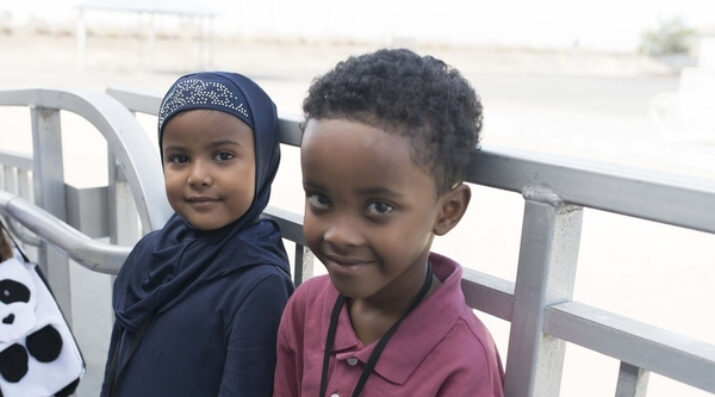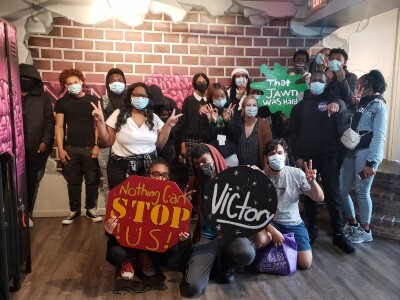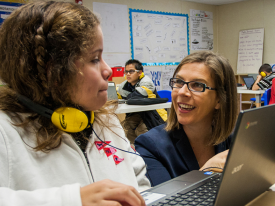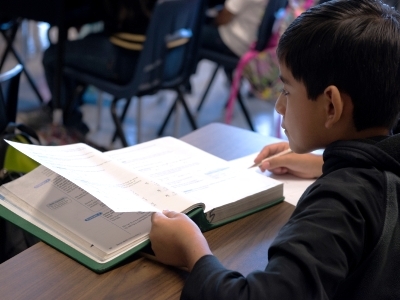Voices, Tools, and Resources for Equity in Education
Topics

Together, educators are doing the reimagining and reinvention work necessary to make true educational equity possible. Student-centered learning advances equity when it values social and emotional growth alongside academic achievement, takes a cultural lens on strengths and competencies, and equips students with the power and skills to address injustice in their schools and communities.
Practitioner's Guide to Next Gen Learning
Resources for educators who are committed to redesigning their schools so that education can be a force for equity and human flourishing.
If you talk to just about anyone in the next gen learning space, you are likely to hear the terms rethink, reimagine, and redesign. These are powerful words because they convey three truths: 1) that the way we think shapes the schools we build; 2) that what we imagine can expand our ideas about what is possible; and 3) that, if education as an institution is not equitable, it’s because it was designed to be that way.
At the same time, the prefix “re” is even more potent. It tells us that we can, and should, think deeper, imagine bolder, and design better than we have in the past. The COVID-19 pandemic and widespread protests against racism and systems of oppression have given educators plenty to rethink. However, many schools, districts, and organizations in the NGLC community are doing more than thinking. They are taking action to transform schools so that education dismantles—instead of perpetuates—an inequitable status quo.
This edition of Friday Focus: Practitioner’s Guide to Next Gen Learning is dedicated to curating and sharing resources for educators who are committed to redesigning their schools so that education can be a force for equity and human flourishing. This collection of resources is drawn from the NGLC website, including the diverse voices of our guest bloggers, tools built in collaboration with equity-focused partners, and resources from organizations with Black, Indigenous, people of color (BIPOC) founders and leaders.
The resources are organized into six themes, as follows:
- Redesigning for equity
- Supporting adult learners and leaders
- Building a school culture of community and equity
- Creating culturally responsive learning
- Teaching for social justice
- Working for equity amidst the pandemic
(Re-) Designing for Equity
Racism and inequity are products of design. They can be redesigned
—Caroline Hill of 228 Accelerator, Michelle Molitor of The Equity Lab, and Christine Ortiz of Equity Meets Design
If we want more equitable school designs, it stands to reason that we’ll have to purposefully “design for equity.” As part of a design thinking process, equity design principles like these from the NGLC Equity Toolkit play an important role in reimagining learning. They make explicit the intended values, qualities, and functionality in the learning experience a school creates for students. In addition to design principles, this resource includes planning and design tools contributed by CityBridge Education and the Center for Collaborative Education (CCE), an Assessment for Learning Project grantee.
To learn about ways schools are putting equity design into practice, you can also read “Designing for Race Equity: Now Is the Time,” an NGLC blog post by CityBridge’s Andrew Plemmons Pratt. In this story, Andrew unpacks the five principles of the equityXdesign framework and shares stories and examples of ways they are put into practice at various schools that partner with CityBridge.
CCE’s “Building for Equity: A Guide for Inclusive School Redesign” provides educators with a framework and tools for driving equity-focused, innovative school change. This guide’s approach emphasizes ways that both culturally responsive learning and personalized, student-centered design can be achieved together.
“What Happened When My School Started to Dismantle White Supremacy Culture,” a post by NGLC contributing blogger Joe Truss, describes how his school came to define their North Star and find their purpose as an anti-racist school. Joe, the principal of Visitacion Valley Middle School in San Francisco, California, explains how exploring and dismantling White Supremacy Culture enabled his staff to build a new foundation and engineer their school for equity.
Using the right kind of data to make educational decisions is the focus of “Street Data: A New Grammar for Educational Equity,” by Shane Safir, author of The Listening Leader: Creating the Conditions for Equitable School Transformation. In her blog post for NGLC, Shane points out that the kinds of data school leaders rely on for decision making further marginalizes the students we claim we want to serve. By contrast, "street data" humanizes the process of gathering data and takes us down to the ground to listen to the voices and experiences of our students, staff, and families.
Supporting Adult Learners and Leaders
[T]o build a new, more inclusive culture, we first needed to be able to see the norms, values, and practices in our institutions that advantage white people and ways of working, to the exclusion and oppression of all others.
—Ben Hecht, in “Moving Beyond Diversity Toward Racial Equity”
Schools and other institutions that have made the commitment to redesign for equity recognize that working toward racial equity involves more than what Ben Hecht, writing in the Harvard Business Review, calls “‘velcro-ing’ new guidelines, practices, or programs onto the existing structures and culture of the workplace.” Creating a culture of equity requires changing ways of being, doing, and communicating. The following set of resources provides support for leaders and educators to learn, practice, and take action to adopt new structures in service to equity.
Professional Learning Sequences in the NGLC Equity Toolkit feature 14 tools and adult learning experiences, from a variety of organizations, designed to develop awarenesses of individuals’ identity and privilege, as well as the structures of power within the classroom, school, and community. In the course of the learning experiences, school leaders actively work toward the creation of equitable practices, policies, and structures and build capacity in equity-based skills and mindsets, including constructivist listening, recognizing dominant discourse, and using consultancy or tuning protocols to support equity-oriented instruction.
Discussion Protocols, also from the NGLC Equity Toolkit, are user-friendly tools to help adult learners construct meaning from reading a shared text. These protocols, from School Reform Initiative and National School Reform Faculty, provide a structured process or set of guiding steps for participants to follow. This process honors multiple lived realities and diverse perspectives and provides a safe space for people to offer different interpretations of the issues and subject matter presented in the text they are discussing.
For guidance in creating a “brave space” for conversations about race that are inclusive to all races, sexes, genders, abilities, immigration statuses, and other lived experiences, explore these Tools for Courageous Conversations from the Remote DEI Collective. This resource also includes considerations for implementation in a remote work environment.
This Organization-Wide Equity Pause Resource from Equity Meets Design notes that, “Our common discourse of urgency and business-as-usual creates little time for reflection; our pace of life eclipses our awareness.” It therefore offers examples and guidance to leaders, challenging them to create ongoing spaces for transformation by pausing other tasks and making the time to do the work of becoming anti-racists in an anti-racist organization.
This story from NGLC’s Friday Focus: Practitioner’s Guide to Next Gen Learning, titled “Share Your DC: A Diversity, Equity, & Inclusion Expedition,” features an equity-focused learning expedition designed for adults in the school community. Khizer Husain, the chief of staff at Two Rivers Public Charter School in Washington, D.C., describes how, over the course of three evenings, Two Rivers educators and parents grapple with the complex problem of creating a strong, diverse community where members can truly connect across difference.
Building a School Culture of Community and Equity
[T]he system of education in the U.S., a western, industrialized, capitalist country, is itself an expression of culture. It has been used to advance and sustain dominant white values as the “norm” and to position everything else as the “other.” When students experience this “othering” and cannot bring all their ways of knowing and being to a learning opportunity, it impacts their willingness, motivation, and ability to learn deeply.
—Sarah Luchs, for NGLC, in “Unpacking Cultural Complexity to Create More Equitable Learning”
Developing new mindsets, structures, and skills among adults is an essential component of designing schools for equity. However, that work alone will not transform the student experience or build equitable and inclusive relationships with families and the communities schools serve. The tools and resources below provide guidance, examples, and food for thought about what it takes to create an inclusive community in which all students are known, valued, and feel as if they belong.
Using personal experience to address the topic of belonging, NGLC contributors Marco Dominguez, an English teacher at Desert Ridge High School in Mesa, Arizona, and Jaime Barraza, chief of staff at Distinctive Schools in Chicago, explore cultural belonging through video storytelling. In “Mr. Sundays: A Latino Teacher's Exploration,“ Marco describes his relationships with learners and also the “great sadness” he feels knowing that he is likely the first and only Latino teacher his students will ever have. Jaime’s video, “My Name is Jaime,” uses the motif of his name—and how it was distorted at school—to tell the story of what it means to be “othered” and, conversely, the power of learning experiences that support students to decide for themselves “what is worthy and what is valuable.”
“Cultivating Anti-Bias and Anti-Racist Leaders of the Future,” a blog post by NGLC grantee Sara Cotner, the founder and CEO of Montessori for All in Austin, Texas, describes the collaborative and inclusive process their flagship school, Magnolia Montessori, followed to develop “Creating a Welcoming & Inclusive Community For All.” This public-facing guide presents, in English and in Spanish, the school’s key understandings for each grade band related to identity, diversity, justice, and action, along with sample texts learners may read and discuss at school or with their families.
“Creating An Intentionally Diverse School: Lessons Learned,” a NewSchools Venture Fund publication, features intentionally diverse schools, including NGLC grantees Thrive Public Schools in San Diego, California, and Valor Collegiate Academies in Nashville, Tennessee. Based on interviews with educators at these schools, the brief emphasizes creating not just a diverse student body, but also an inclusive environment where every member of the school community is valued, respected, and important.
As part of their work to design more equitable models, many schools in the NGLC community are shifting away from traditional disciplinary practices and “command and control” school cultures that disproportionately and negatively affect children of color. Instead, they embrace creating an intentional community, co-created values, and accountability for upholding shared ideals. “School Culture: Restorative Practices,” from the NGLC Equity Toolkit, provides authentic videos and other resources to support implementing restorative practices at your school.
Creating Culturally Responsive Learning
If we’re serious about equity, we need to ask ourselves why cultural responsiveness is not as visible and valued as whole person development and personalization within next gen learning. Let’s start talking about it and propel next gen learning to be that force for equity we need it to be.
—Kristen Vogt, NGLC, in “Why Aren't We Talking about Culturally Responsive Education in Next Gen Learning?”
The stories and resources in this section explore the intersection of next gen learning design and culturally responsive teaching and learning. In “Culturally Relevant Performance Assessment for Students,” for example, NGLC contributing blogger Maya Kaul from the Learning Policy Institute includes this quotation from Gloria Ladson-Billings: "All instruction is culturally responsive. The question is: To which culture is it currently oriented?" Using examples of performance assessments, such as capstone projects, from schools in California and Hawaiʻi, Maya illustrates how schools can foster a sense of cultural belonging among all students, especially those whose cultural identities are not traditionally honored and represented in the classroom.
In “Culturally Responsive Assessment through Nā Hopena Aʻo (HA),” NGLC guest bloggers Brook Taira and Kauʻi Sang from the Hawaiʻi Department of Education in Honolulu, Hawaiʻi, explain how their state is responding to a need for culturally responsive and place-based educational frameworks. The Hawaiʻi DOE, an Assessment for Learning Project grantee, has designed a proficiency-based pathway to prepare students for college, career, and community in Hawaiʻi and beyond. The new set of learner outcomes that emerged from this work, titled Nā Hopena Aʻo (or HĀ), is uniquely grounded in Hawaiian values, language, culture, and history.
“The Intersection of Project-Based Learning and Cultural Responsiveness,” by Riley Johnson at New Tech High in Napa, California, describes how his school begins the year with a school-wide design challenge in which students explore their own culture, the culture of those around them, and the culture that makes up the backbone of their community. Through this shared design challenge, Riley reports, the school community has found ways to be more explicit at identifying what it means to be culturally responsive and, more importantly, what it looks like in action.
Writing for the blog Diverse Issues in Higher Education, Donna Y. Ford, Distinguished Professor of Education and Human Ecology at The Ohio State University, calls attention to the negative effects of adopting culture-blind social emotional learning (SEL) philosophies and frameworks. In “Social-Emotional Learning for Black Students is Ineffective When it is Culture-Blind,” she cautions against simplistic solutions to complex problems like racial trauma, and she urges educators to “understand that there is no way to work effectively with the ‘whole child’ of color when culture is demonized, ignored, discounted, and/or trivialized.”
Teaching for Social Justice
If 2020 has revealed one thing, it's the level of racial and economic inequality that continues to plague our country and world. As future leaders, it's imperative that all of our students, regardless of their ethnicity or zip code, know how to advocate for themselves and their communities.
—Theresa Bruce, Modern Classrooms Project, Baltimore, Maryland
In NGLC’s work with partner schools and districts in our community of practice, we often refer to the importance of not just learning about a topic but learning deeply by doing. The following stories and resources apply that learning design principle to social justice. For example, teacher Theresa Bruce, in her blog post for NGLC, “21st Century Learners as Activists,” explains why teaching advocacy is an essential competency and a priority within her classroom. To illustrate, she describes her unit on civil disobedience, which pushes students “to examine current systemic structures and institutions while also learning about methods of mobilization, organization, protest, and advocacy to utilize outside of the classroom.”
“Transforming High School by Challenging Students to Take Action” by Matt Doyle, superintendent at Vista Unified School District in California, includes a personal narrative by Perla Lopez, a student at Vista High School. In this NGLC blog post, Perla describes her experience in her high school’s Challenge course, a class in which learners investigate a topic, engage with it, and then determine how to take action on their learning by advocating for change.
The ASCD Education Update article “Why We Can't Afford Whitewashed Social-Emotional Learning,” by Dena Simmons, challenges educators to teach “fearless SEL.” The author, who is the assistant director at the Yale Center for Emotional Intelligence, argues that, “We owe our students an education that centers on their lives and explicitly addresses the sociopolitical context. This will not only prepare our students to engage civically and peacefully across difference, but also to become the changemakers and leaders we need.”
For classroom activities, texts, and other resources for teaching and learning social justice at all grade levels, explore these free online resource hubs: “20 Picture Books for 2020: Readings to Embrace Race, Provide Solace & Do Good,” “Teaching for Change: Building Social Justice Starting in the Classroom,” and “Teachers 4 Social Justice: 2020 Resources for Abolitionist Teaching and Solidarity in These Times.”
Working for Equity During a Pandemic
Even though options for connecting are limited right now, we can create spaces in remote settings to provide support, interact, and dedicate time and resources to ongoing action, backing up commitments to equity and racial justice...when the pandemic keeps us isolated, and when racism persists, the distance in our workplaces must not serve as another dehumanizing force.
—Kristen Vogt and Stephen Pham, in “Taking Action toward DEI and Antiracist Commitments Remotely”
As a result of the pandemic, many organizations, including schools, are finding themselves operating in an unfamiliar environment, such as a remote work culture. The resources below are designed to support positional leaders and others to promote equity in spite of physical distance or other challenges. For example, the seven organizations of the Remote DEI Collective (RDC) have been remote or partially remote for longer than the pandemic and are committed to engaging in matters of DEI and antiracism remotely. While the RDC does not claim to have all the answers, they offer some considerations for navigating these unprecedented times in their Remote DEI Toolkit.
In his essay “What’s Next for Schools? Dismantling, Healing, and Refusing to Return to Normal,” Adelric McCain, director of equity and impact for the Network for College Success at the University of Chicago, identifies the disruption of Spring 2020 as an opportunity to radically rethink the power dynamics between students and teachers and points to two areas worthy of inquiry: “First, how do we as educators create learning spaces in which students’ identities truly matter? Secondly, how do we critically examine our practices and beliefs in order to create learning spaces (virtually or in person) where young people are seen and heard, and not just assessed?”
“Schools as Communities of Care,” an NGLC blog post by Jeff Heyck-Williams, the director of the Two Rivers Learning Institute in Washington, D.C., explores the role of schools as community hubs that can support intentional progress toward a more just and equitable society or, as products of a racist White-supremacist culture, intentionally create communities of inequity. Jeff argues that, although educators are right to worry about how disrupted learning will impact our most marginalized students, “the conversation around these inequities...needs to start with the trauma of these times. Schools need to ensure that they are communities of care before they undertake any of their other essential work.”
“Crises as a Catalyst: A Call for Race Equity & Inclusive Leadership,” by ProInspire, is a reflective guide for individuals and organizations to advance race equity and inclusive leadership during crises. In response to “the unprecedented circumstances brought forth by COVID-19 and recent acts of police brutality,” the guide includes questions to support both individual reflection and team discussions to support organizational leadership to “evolve who we are as leaders and ignite an inner transformation that can sustain the work needed to support Black, Indigenous, and communities of color in the social sector as a whole.”
Photo at top courtesy of Thrive Public Schools.




